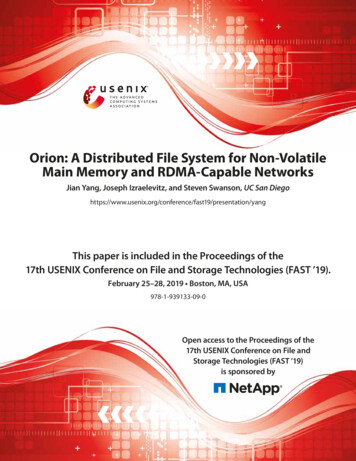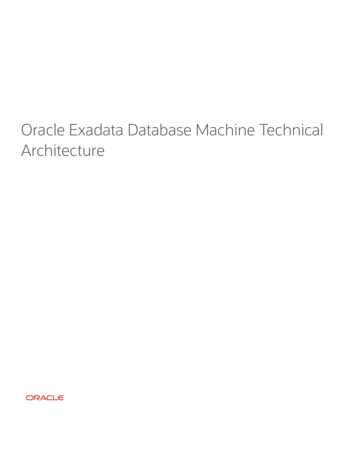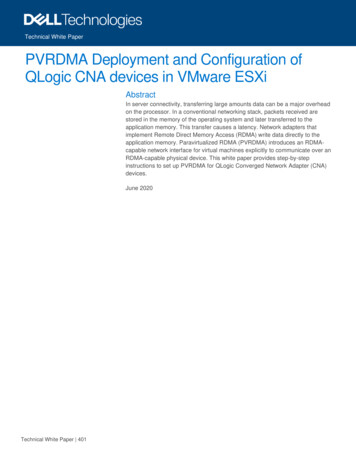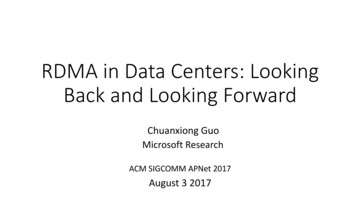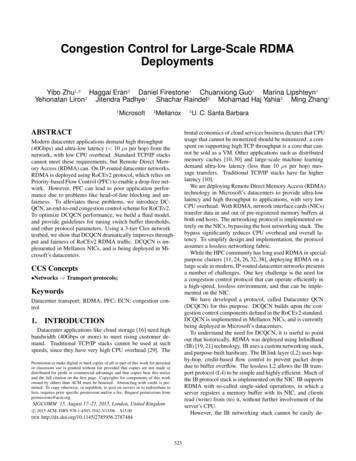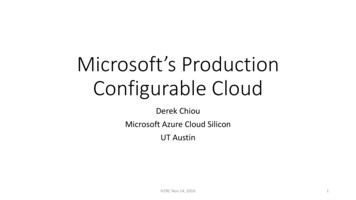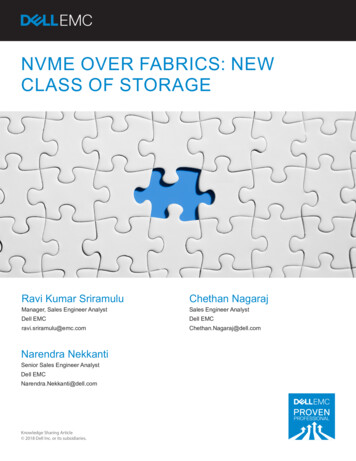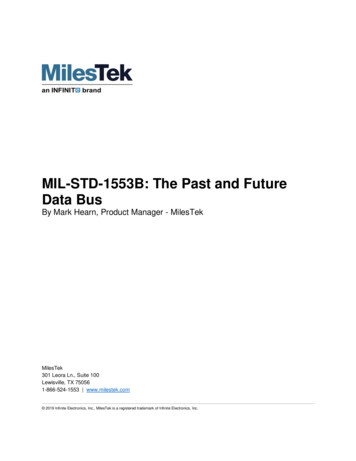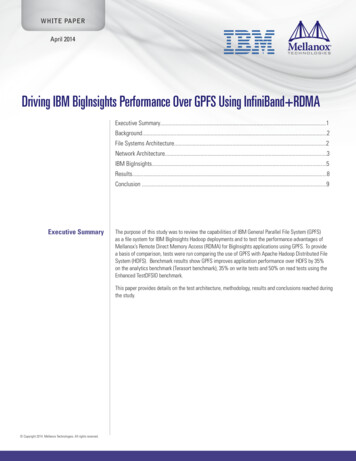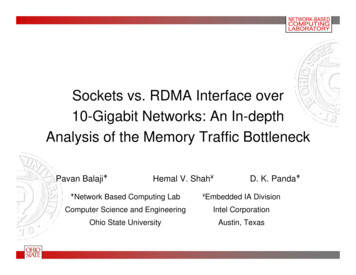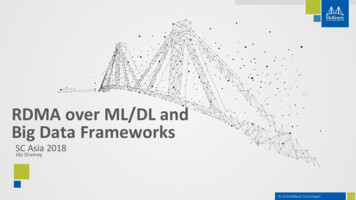
Transcription
RDMA over ML/DL andBig Data FrameworksSC Asia 2018Ido Shamay 2018 Mellanox Technologies1
Exponential Data Growth EverywhereCloudHPCBigDataSecurityInternetof lligence 2018 Mellanox Technologies2
Neural Networks Complexity 014201520162017 2018 Mellanox Technologies3
Distributed Training use case Training with large data sets and the ever increasing neural networks cantake long time In some cases even weeks In many cases training need to happen frequently Model development and tuning Real life use cases may require retraining regularly Accelerate training time by scale out architecture Add workers (nodes) to reduce training time Like in HPC. 2 type of parallelism are now popular: Data parallelism Model parallelism 2018 Mellanox Technologies4
Model and Data ParallelismModel ParallelismData ParallelismMain Model/Parameter hLocalModelMiniBatchLocalModelMiniBatch 2018 Mellanox Technologies5
Model Parallelism Models size is limited by the compute engine (GPU forexample) In some cases the model doesn’t fit in compute Large models Small compute such as FPGAs Model parallelism slice the model and run each part ondifferent compute engine Networking become a critical element High bandwidth, low latency are mandatoryDataData 2018 Mellanox Technologies6
Data Parallelism Data Parallelism communication is network intensive Vast amount of data is distributed to a lot of different computeelements. Training engines need to coordinate their neural networksweights and resynchronized with each other to get a cumulativebenefit. That synchronization is a performance bottleneck and requiresHigh bandwidth, as models become larger and larger Number of weights is increasing in exponential growth. Usually characterized with Bursts on the network, as computingelements are synchronized.Efficient Networking is a Key to Enable Data Parallelism 2018 Mellanox Technologies7
Data Parallelism Synchronous: Workers start the training step together (synchronized) with the same variables. Each worker compute gradients towards the global variables with its data (mini batch). Gradients are synchronized between all workers Either by sending it to parameter servers, which then average it. Or using collectives operations. The averaged gradient is enforced on the global parameters Everyone starts a new step. Effect on the training is that of the accumulated mini batch. Asynchronous: Workers fetch model variables independently. Each worker compute gradient it updates the global variables. Very stochastic process. 2018 Mellanox Technologies8
Spark’s Shuffle use case Shuffling is the process of redistributing data across partitions (AKA repartitioning)Shuffle WriteBroadcast blocklocationsWorker nodes write their intermediate datablocks (Map output) into local storage, and listthe blocks by partitionThe master node broadcasts a combined list ofblocks, grouped by partitionShuffle ReadEach reduce partition fetches all of the blockslisted under its partition – from various nodesin the cluster 2018 Mellanox Technologies9
Spark’s Shuffle use caseReduceMapInputMap outputMapFileMapFileMapFileMapFileMapFileReduce taskFetch blocksReduce taskFetch blocksReduce taskFetch blocksReduce taskFetch blocksReduce taskFetch blocksDriver 2018 Mellanox Technologies10
Three Major Computing Categories Scientific Computing Message Passing Interface (MPI), including MPI OpenMP, is the Dominant Programming Model Many discussions towards Partitioned Global Address Space (PGAS) UPC, OpenSHMEM, CAF, UPC etc. Hybrid Programming: MPI PGAS (OpenSHMEM, UPC) Relatively small-sizes message (order of kilobytes) CPU-based communication buffers Deep Learning Caffe, CNTK, TensorFlow, and many moreWidespread popularity of accelerators like Nvidia GPUsMost of the frameworks are exploiting GPUs to accelerate trainingDiverse range of applications –Image Recognition, Cancer Detection, Self-Driving Cars, Speech Processing etc.Unusually large message sizes (order of megabytes)Most communication based on GPU buffers Big Data/Enterprise/Commercial Computing Focuses on large data and data analysis Spark and Hadoop (HDFS, HBase, MapReduce) 2018 Mellanox Technologies11
Three Major Computing CategoriesNVMe,NVMe Over FabricsSoftwareDefinedStorageBig DataStorageHadoop / SparkSQL & NoSQLDatabaseGPUDirectImage , VideoRecognitionRDMAVoice Recognition& SearchMPIDeepLearningSentiment AnalysisHPCSHARPNCCLFraud &FlawDetection 2018 Mellanox Technologies12
How do those applications looks like ? Most of the time application is doing computation Which is what actually interests the users Parallel communication and computation Start non-blocking send / receive Compute the data for next phase Wait for completion of all requests Typical application flow: Init: Read input file Decompose the problem Work Loop: Compute Data exchange Finalize: Write output file 2018 Mellanox Technologies13
The secret sauce Low Latency ( 1 usec) High Bandwidth ( 100 Gb/s) Scalability Efficient support for communications on largeOS bypass (direct access to the hardware from the user level)Remote Direct Memory Access (avoid memory copies in communication on stack) Read, Write, AtomicsOffloads Collective operations, support for non-contiguous data, GPU-Direct, Peer-Direct, tag-matching, etc. Low software overheadsLow memory footprint (as much as possible)Performance portable APIs 2018 Mellanox Technologies14
What Is RDMA? Stands for “Remote Direct Memory Access” Advanced transport protocol (same layer as TCP and UDP) Modern RDMA comes from the Infiniband L4 transport specification. Full hardware implementation of the transport by the HCAs. Flow control and reliability is offloaded in hardware. Remote memory READ/WRITE semantics (one sided) inaddition to SEND/RECV (2 sided) RoCE: RDMA over Converged Ethernet The Infiniband transport over UDP encapsulation. Available for all Ethernet speeds 10 – 100G Verbs: Low level abstract description of the functionality forRDMA programming. Control path and data path verbs. Several APIs – main one is libibverbs – standard Linux Verbs API. Same abstraction for IB/RoCE/iWARP. Supported on almost all mid-range/high-end network adapters Growing cloud support 2018 Mellanox Technologies15
RDMA Verbs basics Uses Kernel bypass / direct user space access Supports Zero-copy – no need to copy user application buffers toa dedicated NIC buffers.AppbufferControlData Application may scatter/gather to upper layer applications buffersContextdirectly. Direct user space - hardware interface which bypasses the kernelKerneland TCP/IP in data path Sub-microsecond latency. CPU utilization – CPU not involved in the DMA operations. High Bandwidth.DMASocketsTCP/IPDriverNetwork Adapter 2018 Mellanox Technologies16
The Transport types Queue Pair is the actual object that transfers data It encapsulates both Send and Receive Queue A QP represent a real HW resource Connecting QPs – manually or through rdma-cm (defined in Infiniband transport specification). UD – Unreliable Datagram implements only two-sided communication semantics. Single MTU at a time. Connectionless – single QP per process (AV in send/recv) RC – Reliable Connected Support RDMA and large messages in transport Limited number of RC channels, to preserve HCA resources - Every channel is an RC QP DC - Dynamically Connected (Mellanox) dynamically creates and destroys connections memory consumption close to the level of UD, while offering memory semantics, as RC 2018 Mellanox Technologies17
The IB Transport Layer The InfiniBand transport uses the queue pair (QP) model send and a receive queue are used for issuing and receiving Messages respectively. A work request is submitted to these queues, where the hardware can read it to perform thecommunication. Additionally, a completion queue is associated with each queue pair for notification of communicationcompletion. 2018 Mellanox Technologies18
Memory management in RDMA applications Communication over RDMA Verbs requires all memory regions that are accessed by the hardware tobe registered (the famous ibv reg mr verb). Pinned and mapped for the hardware as physical address by the IB core drivers. Memory Region is a virtually contiguous memory block that was registered, i.e. prepared for work withRDMA. Any memory buffer in the process’ virtual space can be registered May specify which permission to allow (remote/local). After a successful memory registration, two keys are being generated: lkey and rkey In order to alleviate the overheads of memory registration, short messages can be inline in the workrequests, whereas larger messages can take advantage of a zero-copy protocol. This strategy means that the work request gets only a description of the memory buffer and later readsthe data directly from the buffer, without any CPU involvement. Some advanced features (Mellanox) ODP – on demand paging avoidpinningthepagesofregisteredmemoryregions UMR - support direct local and remote noncontiguous memory access 2018 Mellanox Technologies19
Peer to Peer communication Direct data transfer between PCI-e devices without the need to use main memory No need for temporary storage in CPU memory. Also control of peers directly from other peer devices Accelerate transfers between different PCI-E devices Improve latency, system throughput, CPU utilization, energy usage Cut out the ipsetVendorDevice 2018 Mellanox Technologies20
Mellanox PeerDirect Natively supported by Mellanox OFEDSupports peer-to-peer communications between Mellanox adapters and third-party devicesNo unnecessary system memory copies & CPU overheadEnables GPUDirect RDMA, GPUDirect ASYNC, ROCm and othersInfiniBand and Vendor0101001011DeviceDesigned for Deep Learning Acceleration 2018 Mellanox Technologies21
NVIDIA GPUDirect RDMA 2018 Mellanox Technologies22
ExamplecudaMalloc(&s buf d, size);s buf h malloc(size, );mr ibv reg mr(pd, s buf h, size, );.// Want to send the CUDA buffercudaMemcpy(s buf h, s buf d, size.);wr.sg list- addr s buf h;wr.sg list- lkey mr.lkey;wr.sg list- length size;ibv post send(qp, &wr, );cudaMalloc(&s buf d, size);mr ibv reg mr(s buf d, size, );.wr.sg list- addr s buf d;wr.sg list- lkey mr.lkey;wr.sg list- length size;ibv post send(qp, &wr, ) 2018 Mellanox Technologies23
How does it work ? Allow ibv reg mr() to register peer memory. Peer devices implement new kernel module – io peer mem Register with RDMA subsystem - ib register peer memory client() io peer mem implements the following callbacks : acquire() – detects whether a virtual memory range belongs to the peer get pages() – asks the peer for the physical memory addresses matching the memory region dma map() – requests the bus addresses for the memory region Matching callbacks for release: dma unmap(), put pages() and release() 2018 Mellanox Technologies24
Before GPUDirect GPUs use driver-allocated pinned memory buffers for transfers RDMA use user pinned buffers for communication It was impossible for RDMA drivers to pin memory allocatedby the GPU Userspace needed to copy data between the GPU driver’ssystem memory region and the RDMA memory region 2018 Mellanox Technologies25
GPUDirect / GPUDirect P2P GPU and RDMA device share the same “pinned” buffers GPU copies the data to system memoryRDMA device sends it from there Eliminate the need to make a redundant copy in CUDA host memory 2018 Mellanox Technologies26
GPUDirect RDMA / PeerDirect CPU synchronizes between GPU tasks and data transfer HCA directly accesses GPU memory Direct path for data exchange Eliminate the need to make a redundant copy in host memory 2018 Mellanox Technologies27
GPUDirect ASYNC GPUDirect RDMA (3.0) – direct data path between the GPU and Mellanox interconnect Control path still uses the CPU CPU prepares and queues communication tasks on GPU GPU triggers communication on HCA Mellanox HCA directly accesses GPU memory GPUDirect ASYNC (GPUDirect 4.0) Both data path and control path go directlybetween the GPU and the Mellanox interconnectMaximum PerformanceFor GPU Clusters 2018 Mellanox Technologies28
GPUDirect Async / PeerDirect Async Control the HCA from the GPU Enable batching of multiple GPU and communication tasks Reduce latency Reduce CPU utilization Light weight CPU Less power CPU prepares and queues compute and GPU triggers communication on HCA HCA directly accesses GPU memorycommunication tasks on GPU 2018 Mellanox Technologies29
Code example GPUDirect RDMAwhile(fin) {gpu kernel , stream (buf);cudaStreamSynchronize(stream);ibv post send(buf);ibv poll cq(cqe);} 2018 Mellanox Technologies30
Code example GPUDirect ASYNCwhile(fin) {gpu kernel , stream (buf);gds stream queue send(stream, qp, buf);gds stream wait cq(stream, cqe);} 2018 Mellanox Technologies31
How does it work ? Create a QP - Mark it for PeerDirect Async - Associate it with the peer Post work requests using ibv post send() Doorbell is not ringed Use ibv peer commit qp() to get bytecode for committing all WQEs currently posted to the send work queue Queue the translated bytecode operation on the peer Peer executes the operations after generating outgoing data 2018 Mellanox Technologies32
So now what ? So RDMA is really a P2P memory semantics programing.Application API Also the 2 sided SEND/RECV must be in order. Application needs to know what/when came from the RDMAand use it when it wants.P1P2P3 Applications (sometimes – depends on its nature) needmessage passing semantics protocol on top of the RDMA.MemoryMemoryMemory So application usually need to implement messaging protocolover the RDMA. So operations are based on identifiers of the application (like in MPI tags) Sender specifies which message to send when ready. Receiver specifies which message it expect to receive in a given moment.Verbs API 2018 Mellanox Technologies33
Point to Point message protocols (MPI) Eager Sender sends the tag data to receiver Send() is completed immediately* (unless sender is using zero-copy)Receiver must store the data until it’s matchedMay exhaust memory on the receiverTypically used for small-medium messagesUsually means no GPUDirect RDMA Rendezvous Sender sends only the tag to the receiverSend() is not completedReceiver requests the data from the sender when it matches the tagData can be stored directly to the receiver buffer, since it’s already matched use RDMA for zero-copy receive Typically used for large messages Configurable threshold for protocol switch 2018 Mellanox Technologies34
Rendezvous exampleApp SEND msg XRTS( rkey)App RECV msg XRDMA READTag match XBufferrkeyCompleted XCompleted XRNDV RECV DONEFree buffer 2018 Mellanox Technologies35
Protocol threshold calculation: rendezvous vs.eager (From MXM) Estimate performance of each protocol Based on: wire speed, latency overhead, registration cost, Find the point where one protocol is better than another The intersection point is the thresholdFor InfiniBand EDR: eager zcopy bandwidth (x message size):Rendezvous/eagerthresholdmemreg costmemcpy bwsend overhead Rendezvous RDMA bandwidth:memreg costfabric latencysend overheadwire speed Threshold: 30k 2018 Mellanox Technologies36
Common pitfalls Rendezvous and Zero-copy are different things The relation between them is that zero-copy on receiver side can bedone only with rendezvous (or hardware assisted tag matching) Scale Which transport to use ? Maybe hold set of multiple transport resources per use case ? Zero copy can be slower Zero copy improves CPU usage, not bandwidth* Whether zero copy is useful or not depends on the application. GPU Direct RDMA edge cases Not in all cases GPUDirect RDMA zero copy is better Depends on the topology of the peers (GPU and HCA), can also dependson the message size. Memory All buffers must be registered, how many buffers to use. Bounce buffers may be needed. 2018 Mellanox Technologies37
UCX – Unified Communication X So maybe we need all this expertise in one place ? Collaboration between industry, laboratories, and academia Open-source production grade communication framework for HPC and data-drivenapplications Goal is to enable the highest performance through co-design of software-hardwareinterfaces Simple and consistent API Protocols and transports are selected by capabilities and performance estimations, ratherthan hard-coded definitions. 2018 Mellanox Technologies38
UCX stackApplicationsMPICH, Open-MPI, etc.RPC, Machine Learning, etc.PGAS/SHMEM, UPC, etc.SPARK, Hadoop, etc.UC-P (Protocols) – High Level APIUCXTransport selection, cross-transport multi-rail, fragmenetaion, emulation of unsupported operationsMessage Passing API Domain:send/receive, tag matchingI/O API Domain:StreamTask Based API Domain:Active MessagesPGAS API Domain:Remote memory accessUC-T (Hardware Transports) – Low Level APIUC-S(Services)Send/Recv, RMA, Atomic, Tag-matching, Active MessageTransport for RoCE/IB VerbsRCDCTUDOFA Verbs DriverTransport for GPU memoryaccessCUDAROCMCudaROCMOther transportsCommon MemorymanagementHardware 2018 Mellanox Technologies39
UCP API – send/receive Non-blocking send:ucs status ptr t ucp tag send nb(ucp ep h ep, const void*buffer, size t count, callback cb,.) Non-blocking receive:ucs status ptr t ucp tag recv nb(ucp worker h worker,void *buffer, size t count, callback cb.); 2018 Mellanox Technologies40
Collectives So RDMA only support a message passing from one process to another. In this sense, these commands arecalled point-to-point communication commands. In many other occasions, we want to let one process to send data to all the other processes, or gatherdata from all the processes to one process.These operations are called collective communications. In theory, collective communication can be achieved by a combination of point-to-point communications,but using collective communications make the code simpler and maybe faster. There are numerous algorithms to perform every collective operations (active academic research) Optimized for different scales / message sizes / networks Examples: Recursive doubling, Pairwise exchange, Fain-in, fan-out, Reduce-scatter/Allgather, Linear,Bruck, etc. Mellanox HCOLL - hierarchical collectives, based on point-to-point, multicast, core-direct. 2018 Mellanox Technologies41
All Major Machine Learning Frameworks SupportRDMA TensorFlow Native RDMA support distributed TensorFlow: “verbs” – Donated primarily by Yahoo “gdr” – with GPUDirect RDMA - Donated Bairen Yi (HKUST). Via OpenMPI and NCCL2 for Horovod distribution. Caffe2: Support with GLOO Supports peer to peer and collectives with native RDMA Microsoft Cognitive Toolkit: Native support of MPI (OpenMPI)Cognitive Toolkit Paddle Paddle: Native support NVIDIA NCCL: Native and NCCL2 Spark – RDMA support (add spark logo) 2018 Mellanox Technologies42
TensorFlow TensorFlow is an open source software library for numericalcomputation using data flow graphs Second generation deep learning system from Google. (based onDistBeleif framework) Front-end in python/C for model definition. Runtime backend in C , linear algebra packages and GPU support. Model design transparent to infrastructure/scale: Abstracts away the underlying hardware. Same program for different infrastructure. Nodes in the graph represent mathematical operations, while thegraph edges represent the multidimensional data arrays (tensors)communicated between them. Graph is all Operations and Tensors (and maybe also devices) 2018 Mellanox Technologies43
Distributed TensorFlow Tensor flow has built in support for distributed execution. Sessions - Actual runtime lifting of a graph. Translate graph definition to executable operation distributed across devices(compute resources). Devices – CPU/GPUs. Nodes/operations placement on devices. May add SEND/RECEIVE nodes – where a Tensor traverse two differentdevices. Running a TensorFlow cluster: Running TensorFlow server program, with one or more worker, on each node.Use the devices scatters around the cluster in the TensorFlow graph.TensorFlow server class can be implemented by others to add extra support Like in the case of the RDMA implementations. All the RDMA plugins use the default GRPC layer by adding the RDMA backboneand only implement the RendezvousMgr interface. The SEND/RECV nodes communicate with each otherby an abstract Rendezvous interface, supplied to the SEND/RECVkernels in their construction phase by the session. 2018 Mellanox Technologies44
The TensorFlow Rendezvous Interface A non-blocking Send operation, whichreceive the Tensor it needs to send andits device information (which deviceholds this tensor, memory allocator forthis tensor memory).OperationOperationTensor TTensor TData (Device) An asynchronous Receive operationwhich is supplied with a callback function(to be called when the Tensor is ready)and device information of where to placethis Tensor when calling the callback.Data (Device)Metadata: shape, size, ty peMetadata: shape, size, typeCallbackSendRecvRendezvous Send:Rendezvous Recv:T, deviceNon blockingstep id, Callback(T)Asynchronus 2018 Mellanox Technologies45
The RendezvousMgr Interface TensorFlow allows for external implementations of RendezvousMgr to be “plugged” in. The SEND/RECV nodes use the above functionally of the abstract Rendezvous interface,without really knowing which Rendezvous implementation is being used (Implementation ischosen by the session). Interface allows proprietary implementations of Rendezvous SEND/RECV and essentiallydefers the entire Tensor passing mechanism (default is dezvousMgr 2018 Mellanox Technologies46
First verbs implementation example First implementation was not using zero copy and used eager mode. Motivation was to save the memory registration operations. GPUDirect RDMA couldn’t have work since it worked only with pinned CPU buffer. That means there is always 1 copy for CPU tensors, and 2 copies for GPU tensors. 2018 Mellanox Technologies47
TensorFlow GPUDirect RDMA In order to apply GPUDirect RDMA 0 copies approach: Reduce the CPU tensors copies to 0 (always) GPU tensors copies to 0 for RDMA compatible GPUs, and 1 for other GPUs. No longer allocate a fixed CPU buffer per tensor, since we want the write to be done directlyto the result Tensor’s buffer. The result Tensor is allocated on the receiver side BEFORE it sends the request. This way theremote address and rkey can be delivered inside the request itself GDR’s (Bairen Wi) allocation theme: the result Tensor is allocated on an already registered memory region, whether it is a CPU tensor or a RDMA compatible GPU Tensor.The Sent Tensor was already allocated at the moment of the SEND operation.So we can inherit and implement a new memory allocator which will do the registration automaticallyOn new GPU allocations, which usually are being allocated in big chunks (good for performance). 2018 Mellanox Technologies48
Example Results – Distributed TensorFlow 2018 Mellanox Technologies49
Tencent Amber Deep Learning Framework Provides 2X bandwidth than TCP in VGG Delivers 2.5X performance than TCP in localps mode Delivers 5X performance than TCP in default mode Provides 5X bandwidth than TCP in ego network Linear scale up for CNN, VGG16 and AlexNet modelsMellanox RoCE Provides 2.5X Better Performance over TCPDelivers 5X Better Network Bandwidth and Linear Scalability 2018 Mellanox Technologies50
2X Acceleration for Baidu Machine Learning Software from Baidu Usage: word prediction, translation, image processing RDMA (GPUDirect) speeds training Lowers latency, increases throughput More cores for training Even better results with optimized RDMA 2X Acceleration for Paddle Training with RDMA 2018 Mellanox Technologies51
NCCL2.0 with RDMA Optimized collective communication library between CUDA devices. Easy to integrate into frameworks, as well as for traditional HPC (MPI) Runs on the GPUs using asynchronous CUDA kernels. Operates on CUDA pointers, operations tied to CUDA stream. Support Point-to-Point communications and collectives inter-node communications. Inter-node communication using Sockets or Infiniband verbs, with multi rail support, topology detection and automaticuse of GPUDirect RDMA. Optimal combination of NVLink,PCIe and network interfaces to maximize bandwidth and create ringsacross node. 2018 Mellanox Technologies52
NCCL2 GPUDirect RDMA example 2018 Mellanox Technologies53
Mellanox Accelerates NVIDIA NCCL 2.050%PerformancIemprovementwith NVIDIA DGX-1 across32 NVIDIA Tesla V100 GPUsUsing InfiniBand RDMAand GPUDirect RDMA 2018 Mellanox Technologies54
Horovod Distributed training framework for TensorFlow Inspired by work of Baidu, Facebook, et al. Uses bandwidth-optimal communication protocols Makes use of RDMA (Both RoCE or InfiniBand) Seamlessly installs on top of TensorFlow via pip install horovod Named after traditional Russian folk dance where participants dance in a circle with linked hands 2018 Mellanox Technologies55
ChainerMN Depends on InfiniBand ChainerMN depends on MPI for inter-node communication NVIDIA NCCL library is then used for intra-node communication between GPUs Leveraging InfiniBand results in near linear performance Mellanox InfiniBand allows ChainerMN to achieve 72% accuracy.Source: of-Distributed-Deep-Learning-Using-ChainerMN.html 2018 Mellanox Technologies56
ShuffleManager Plugin Spark allows for external implementations of ShuffleManagers to beplugged in Configurable per-job using: “spark.shuffle.manager” Interface allows proprietary implementations of Shuffle Writers andReaders, and essentially defers the entire Shuffle process to the newcomponentSortShuffleManager SparkRDMA utilizes this interface to introduce RDMA in the ShuffleprocessRdmaShuffleManager 2018 Mellanox Technologies57
SparkRDMA – Accelerate Apache Spark by 40% HiBench TeraSortShuffle Manager plugin for Apache SparkRDMA acceleration for Spark Shuffle transfersOpen-source on GitHub: https://github.com/Mellanox/SparkRDMAEasy and seamless deployment, on a per-job GroupByKeyx1.392010Seconds 2018 Mellanox Technologies58
HDFS RDMA All-new implementation of RDMA acceleration for HDFS Implements a new DataNode and DFSClient Data transfers are done in zero-copy, with RDMA Lower CPU, lower latency, higher throughput Efficient memory utilization Initial support: Hadoop: HDFS 2.6 Cloudera: CDH 5.10 Future: Erasure coding offloads on HDFS 3.X NVMeF 1.0 GA is scheduled for end of Q1 2018 WRITE operations over RDMA READ operations still carried over TCP in this version 2018 Mellanox Technologies59
RDMA Proven Advantages RDMA delivers performance advantage over traditional TCP Machine Learning and HPC platforms share the same interconnect needs Scalable, flexible, high performance, high bandwidth, end-to-end connectivity Standards-based and supported by the largest eco-system Supports all compute architectures: x86, Power, ARM. Native Offloading architecture GPUDirect RDMA accelerations Backward and future compatible 2018 Mellanox Technologies60
Thank You 2018 Mellanox Technologies61
RoCE: RDMA over Converged Ethernet The Infiniband transport over UDP encapsulation. Available for all Ethernet speeds 10 -100G Verbs: Low level abstract description of the functionality for RDMA programming. Control path and data path verbs. Several APIs -main one is libibverbs -standard Linux Verbs API.
